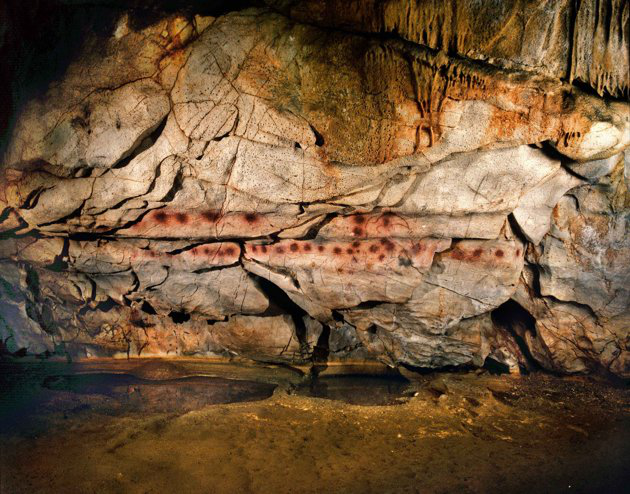
The Panel of Hand dots and stencils at El Castillo, one “dot” 40 800 BP, another 37 300 BP (U/Th method on calcite)
Some seem to be women's hands, see Penn State U. pdf
Who Painted the Great Paleolithic Caves?
The Peripheral Evidence
41 000 BP – 12 000 BP
This page presents a selection of the archeological Paleolithic Cave
Paintings in chronological order. They are intended to give an
impression of the “State of Paleolithic Art” between 40 000 and
12 000 BP. Included are places of general interest, and caves which
exhibit engravings rather than paintings and drawings.
The Caves
of Chauvet, Lascaux, and Altamira have their own web pages. Likewise
the finds of earlier, lower paleolithic sculptures are discussed in a
separate “Venus Street”
chapter. Another chapter presents the record of the Neanderthals
especially of their burial sites, which in my opinion reflect customs
and rites “Modern Man” (H.sapiens sapiens) adopted from the
Neanderthals on his march from the Indian Subcontinent into Europe
around 70 000-40 000 BP.
El Castillo
Near Puente
Viesgo and Altamira. Cantabria, Spain
The “oldest cave
paintings” found so far in Western Europe
40 800 BP

The
Panel of Hand dots and stencils at El Castillo, one “dot” 40 800
BP, another 37 300 BP (U/Th method on calcite)
Some seem to be
women's
hands, see Penn
State U. pdf
This photo by Pedro Saura/AAAS shows the 'Panel of Hands' in El Castillo Cave: red disks (dots) and hand stencils made by blowing or spitting powdered ochre onto the wall. A date from the [calcified] coating of the disks shows the painting to be older than 40,800 years making it the oldest known “cave painting”. The bisons overlay the hands and were painted later. New tests show that crude Spanish cave paintings of a red dot and handprints are slightly older. They might have even been made by Neanderthals.
Note: Blown hand stencils can be found in many caves and at all ages right into historical times (e.g., American Indians, Australian aborigines, our own children!). They are in themselves no sign of old or primitive painting.
The paintings in this cave have many animal representations, among them drawings of dogs, uncommon in this area of Cantabria.
Remains of cave paintings covering the Achelense period down to the Bronze Age can be found in its 18-metre depth. The earliest paintings are hands in negative, of which some 45 examples have been found. There are also 50 signs and 180 representations of animals, especially goats. Among the drawings, those of horses, deer and bison are outstanding and there are also mammoths and dogs. The black paintings are from an intermediate period. The coloured ones are the most recent, as is the case with the red mammoth.
Quote; “Testing the coating of paintings in 11 Spanish caves,
researchers found that one is at least 40,800 years old, which is at
least 15,000 years older than previously thought. That makes them
older than the Chauvet paintings by almost tenthousand
years.
Scientists dated the Spanish cave paintings by measuring
the decay of uranium atoms, instead of traditional carbon-dating,
according to a report released by the journal Science. The oldest of
the paintings is a red dot from El Castillo. About 25 outlined
handprints in another cave are at least 37,300 years old. Slightly
younger paintings include horses.
The authors of the study say they could have been from modern man
decorating their new sanctuaries, or they could have been the works
of the long-time former tenants of Europe: the Neanderthals.
Scientists said Neanderthals were in Europe from about 250,000 years
ago until about 25,000 years ago. Modern humans arrived in Europe
about 41,000 to 45,000 years ago — some claim that they moved in
even earlier — and replaced Neanderthals. ( Quote from Sciencemag,
15 June 2012)
"There is a strong chance that these
results imply Neanderthal authorship," Zilhao said. "But we
have not proven it "
In a telephone press conference, Zilhao
said that Neanderthals decorated their tools and bodies. So, they
could have painted caves.
Eric Delson, a paleoanthropologist at
the American Museum of Natural History in New York, and John Shea at
Long Island's Stony Brook University said the dating work in the
Science paper is compelling and important, but they didn't quite buy
the theory that Neanderthals could have been the artists.
"There
is no clear evidence of paintings associated with Neanderthal tools
or fossils, so any such evidence would be surprising," Delson
said. He said around 41,000 years ago Neanderthals were already
moving south in Europe, away from modern man and their
caves.”
Abbreviated quote from seattlepi.com
Altamira
Santillana del Mar, Cantabria,
Spain
35 600+16 000-12 000 BC
see my chapter on Altamira
Chauvet's Cave
near Saint-Paul-Trois-Chateaux,
Ardeche, France
33 000-30 000 BP
See my chapter on Chauvet's Cave
Cueva de los Casares
near
Riba de Saelices, Guadalajara, Spain
30 000-25 000 BP
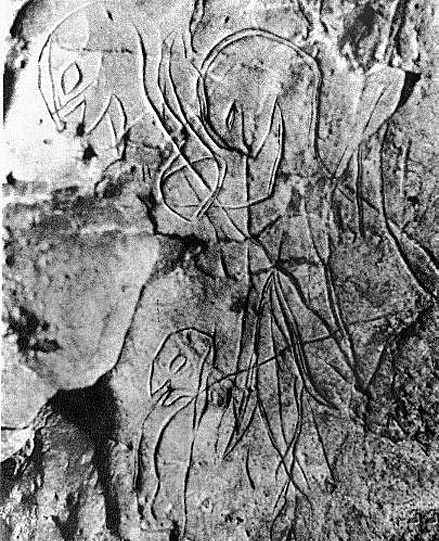
Engraving
of people in the Cueva de los Casares
A special cave is the Cueva de los Casares. There are references to
the cave since at least the first half of the nineteenth century, but
until 1933 there is no reference to the engravings. It contains a
large number of confusing engravings dated to the Middle Paleolithic,
about 200 drawings one on top the others, a few badly damaged. There
are also animal engravings poorly represented elsewhere, such as that
of a mutton – and of Man....
The cave has become famous for
haboring a series of engravings, which are thought to be the first
representation of human reproduction. Foremost among these acts and
statements such as intercourse (one of three known representations in
Paleolithic art), pregnancy, childbirth and family life.
The engravings – leave alone their subject matter – are difficult to see and more difficult to decipher (like the photograph above). Line tracings are about the only way to reproduce them. The Spanish Wikipedia shows the few tantalizing tracings given below.
There are similar drawings in Altamira (16 000 BP) [not reproduced in the internet], so one can doubt the dates given to the Casares engravings. Still the first apearance of human representations (drawings) in the prehistoric record seems to have taken place between 25 000 and 12 000 BP: Cussac (22 000), Gönnersdorf (16 000), Rouffinac (12 000). They all appear to have been produced by H.sapiens. - Accurate dating of rock engravings is difficult.
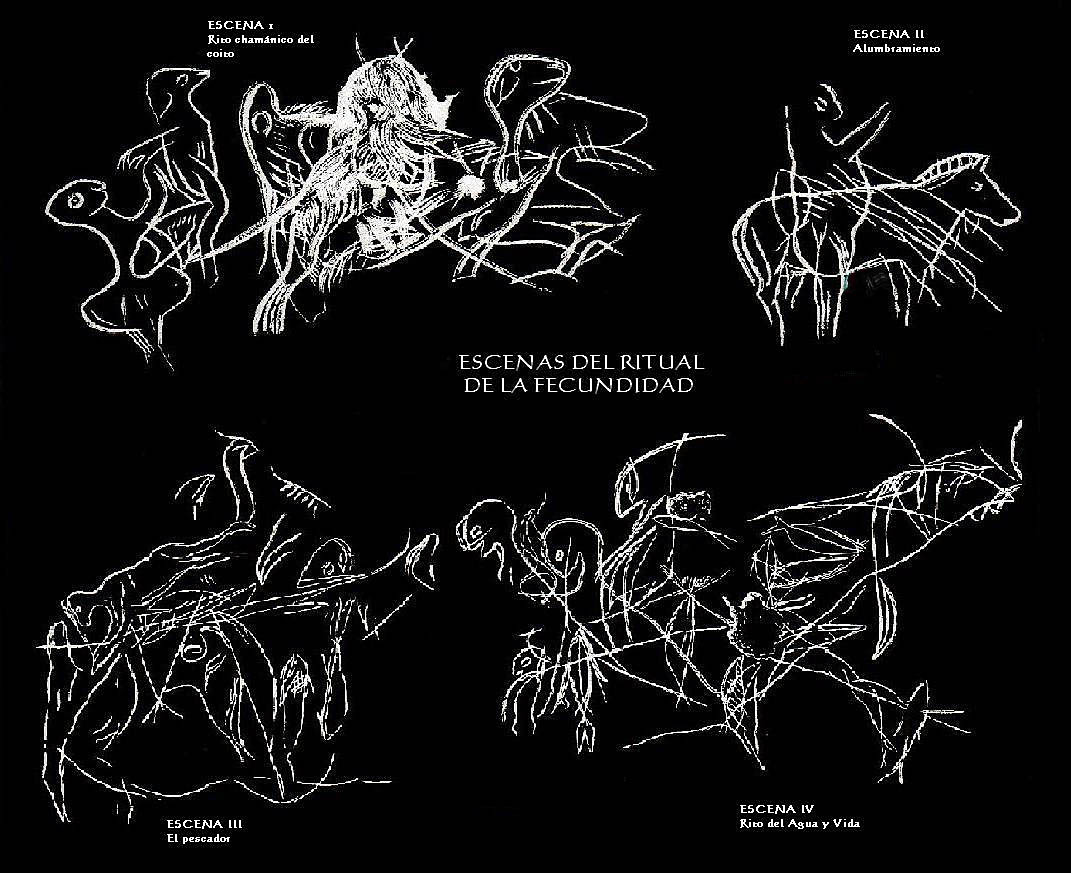
Tracings
of the engravings, Prehistoria
de Guadelajara
The drawings were discovered by brothers Rufus and Claudio Ramírez,
with Rufus being the schoolteacher at Saelices Riba. Soon they saw
that the scope of his discovery was of such importance it that should
be studied by people specializing in this field, reporting on it to
Francisco Layna Serrano, physician and historian of the province of
Guadalajara, who spoke in his chronicles of "strange snakes
chains that were on the ground.
Goolge-translation of Wikipedia.es
Cosquer's Cave
On
the coast south of Marseille, only accessible from below the sea
27
000 and 19 000 BP
Photos from Jean
Clottes et al
|
|
|
Hand stencils form the earliest level 27 000 BP Jean Clottes et al
Cosquer's cave is located in the Calanque de Morgiou near Marseille,
France, not very far from Cap Morgiou. This cave, the entrance of
which is located underwater now, was discovered by Henri Cosquer in
1991. During the Paleolithic the cave's entrance was above sea
level.
This cave contains several dozen paintings and carvings
dating back to the Upper Paleolithic, matching two different phases
of occupation of the cave:
The two main phases in the art of Cosquer, the earlier hand stencils and the finger tracings are from the Gravettian (27 000 BP), while most of the animal paintings and engravings appeared to belong to the later phase around 19 000 BP. This was confirmed by direct radiocarbon datings. 27 dates were obtained which for the most part cluster into two groups, one around 19,000 BP and the other around 27,000 BP. After the Chauvet Cave, Cosquer is the rock art site where most radiocarbon datings have been made (Clottes & Courtin 1994, 1996, Clottes et al. 1996, 1997).
Older drawings of hand stencils and other related motifs, dating back to 27,000 BP. Newer drawings of signs and animals dating back to 19,000 BP (Solutrean), representing both "classical" animals such as bisons, ibexes, and horses but also marine animals such as seals and what appear to be auks and jellyfish.
|
Engravings form the earlier level 27 000 BP, Jean Clottes et al
In the summers of 2002 and mostly of 2003, after Jean Clottes learnt how to scuba-dive for the express purpose of going to the cave, we did an in-depth study of it. First, we carried out a careful examination of the walls and roofs with the help of LED lamps, which are the best sources of light to discover fine engravings, to work out their superimpositions and, more generally, to study the traces of human activities on the surfaces.
The total of figures is now 177 animals. They belong to 11 different species, which is rather unusual in Upper Palaeolithic art, since if 14 species are represented in Chauvet, only 6 are known in Niaux and 9 in Lascaux. The 11 species in Cosquer are horses, bison, aurochs, ibex, chamois, saiga antelope, red deer (stags and does), megaloceros deer, feline, auks, seals. In addition, we have discovered 1 human with a seal's head, 44 black hand stencils and 21 red hand stencils, 216 geometric signs, 20 indeterminate figures, 7 others (like traces, holes in the walls, etc). We have now 78 more animal figures than those recorded in our preliminary book (Clottes & Courtin 1994, 1996).
|
|
|
Black drawings/paintings form the later level 19 000 BP, Jean Clottes et al
We can now state that the Cosquer
Cave used to be one of the most important cave art sites in Europe,
comparable to Lascaux, Trois-Frères, Altamira or Chauvet. This
is because we are only left with a small part of the art. Exploring
the submerged passages and chambers has shown that between three
quarters to four fifths of the whole network is now under water where
the walls and vaults are corroded by the sea and by the shells and
algae so that no painting or engraving could be preserved.
Therefore
there could originally have been
anything between 400 and 800 animal figures in the cave. A number of
small animal engravings - which had been seen in 1992 but had
remained unstudied - are to be found on the slanting wall next to the
big now submerged shaft, which we have called the Big Shaft. They are
difficult of access because the water is quite deep at the foot of
the wall.
The lower level of the water during our second spell of
field work in 2003 has enabled us to spend more time there and to
take close-ups of those engravings and of the black hand stencils
nearby. Contrary to what we had thought first, we found out that they
had been done before the hand stencils, because one of those hand
stencils was on top of these engravings. This
means that part of the animals were done during what we called Phase
1 by the Gravettians, between 26,000 and 28,000 BP, which is an
important new fact;
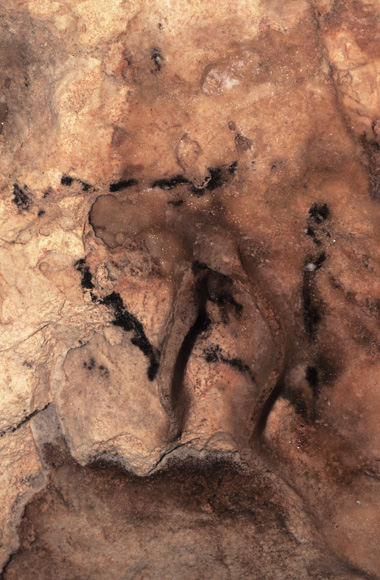
A
hole marked to evoke the female sex, Jean
Clottes et al
In addition to a phallus described previously (Clottes, Courtin,
Collina-Girard 1996), other sexual symbols, both male and female,
have been observed. In particular, a few natural hollows on the walls
have been marked with black to transform them into an image of a
female sex.
Bradshaw
Foundation, Jean Clottes
See also Wikipedia
Font-de-Gaume
near Les
Eysies, Dordogne, France
25 000 BP
What is so special about Font de Gaume is that the animals are
carved, then painted . It's a great thing, because if the paint
disappeared, most of the carving can still be seen. About 3 years
ago, the owners renovated the ground of the cave for tourists. Before
doing that, they studied the walls again, to be sure they did not
miss any paintings. They discovered somewhere near 180 new objects,
from animals to simple signs. Many of them were behind a layer of
calcite, and can be seen only with a UV or IR light.
Text and
photos from Don's
Maps

A
row of Bisons carved and painted, Photo hominides.com
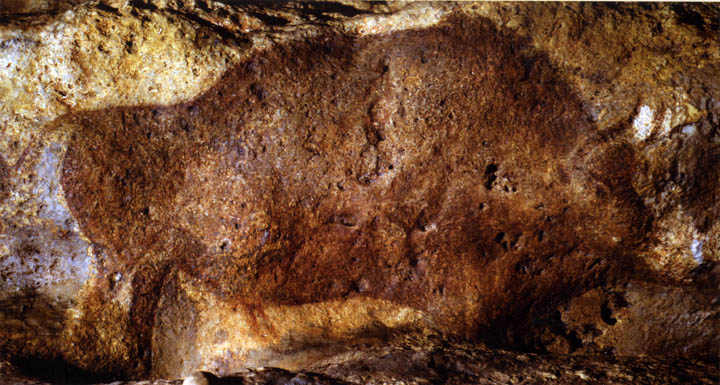
Close-up
of the second Bison from the left. Photo N. Aujoulat/Don's Maps

Deer
and Bisons, Photo N. Aujoulat/Don's Maps
Grotte de Cougnac
north
of Gourdon, Lot, France
25 000+14 000 BP
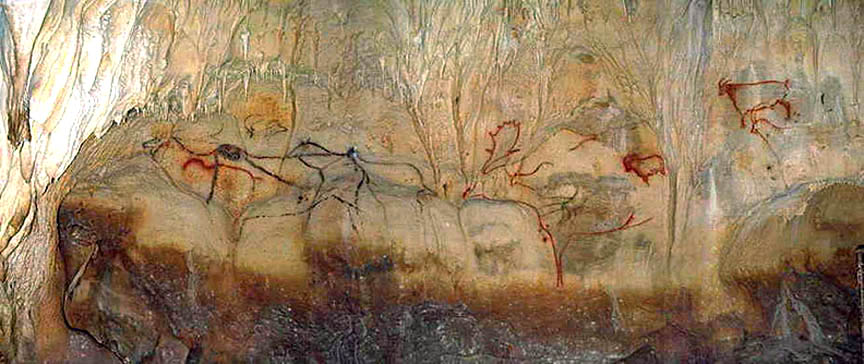
A
cavalcade of deer, ibexes, and a megaloceros, 25-23 000 BP, Photo
grottesdecougnac/Don's
Maps
The Grottes de Cougnac consists of two caves separated by 200 metres. The first contains many concretions, some very fine, called soda straws. The second is a decorated cave from the Paleolithic. Les Grottes de Cougnac were discovered in 1952 by Lucien Gouloumès, et al. It has many prehistoric paintings dated to the upper Paleolithic. Depictions include deer, megaceros, ibex, and mammoths as well as schematic human figures, interpreted as wounded men, virtually identical to similar figures at Pech Merle (16 000 BP).
Direct dating has been carried out by the carbon 14 method on samples of carbon used for some drawings. They showed that the paintings corresponded to at least two clearly distinct phases: one around 25 000 BP (Gravettian) corresponding to the animal figures, the other about 14 000 years BP (Magdalenian) to the hand-dots, and human figures, which were obviously applied by a later visitor to the cave. There are 60 images of animals, 50 stencils of hands, and 3 schematic images of humans (14 000 BP).
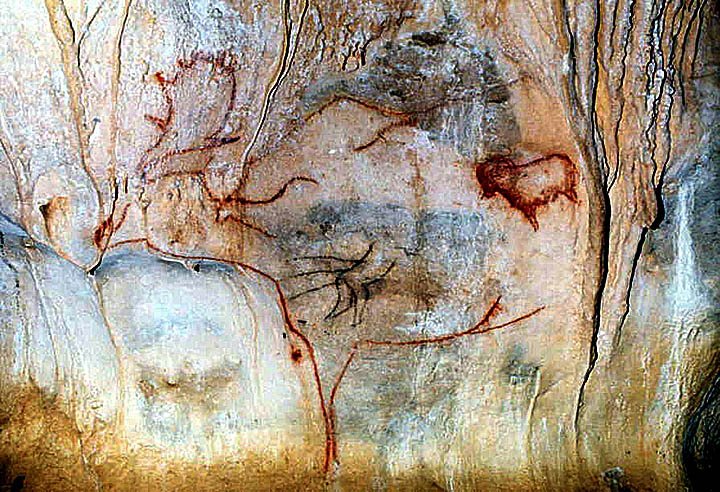
Another
photo of the megaloceros reveals a man with three spears in his back
added later, 14 000 BP
Local red ochre was used to paint the figures. Cougnac was the site
of the first direct radiocarbon date for Ice Age cave art. In the
late 1980s, Michel Lorblanchet had a sample taken from a black
charcoal dot located near the last mammoths (not shown) on the right
hand end of the frieze. It yielded a date of about 14 000 BP; samples
of paint from one male megaloceros later produced dates of 23 610 and
22 750 BP, while the female megaloceros yielded two very different
dates 25 200 and 19 500 BP. This may indicate that the cave's art was
originally produced 25-23 000 years ago, and was subsequently
“touched up” a few millennia later, while the dots indicate that
some Magdalenians entered the cave much later and, while respecting
the original art, marked the walls with their hands. - They left no
“aviforms” as in Pech-Merle (see Venus
Street chapter).
Text modified and photos from Don's
Maps
Pech-Merle
Lot,
France
Decidedly an H.sapiens site
25-16 000 BP
Pech Merle, a hillside opening in the Lot département of Midi-Pyrénées region in France, about 35 minutes drive east of Cahors, is one site of prehistoric cave paintings in France remaining open to the general public. Going back inside for more than a mile are caverns with walls painted in dramatic murals dating back to 25,000 BP (Gravettian culture). Some of the paintings and engravings could be later (Magdalenian, 16, 000 BP).
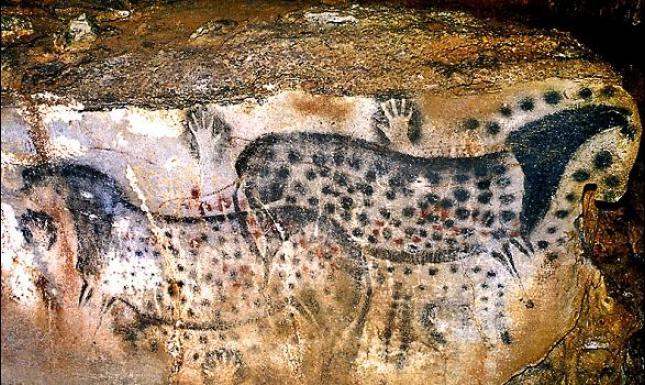
Spotted
horses surrounded by hand stencils and dots.
New (2011)
genetic tests have shown that such dappeled horses actually existed
in paleolithic times and have not sprung from the mythical
imagination of the artist.
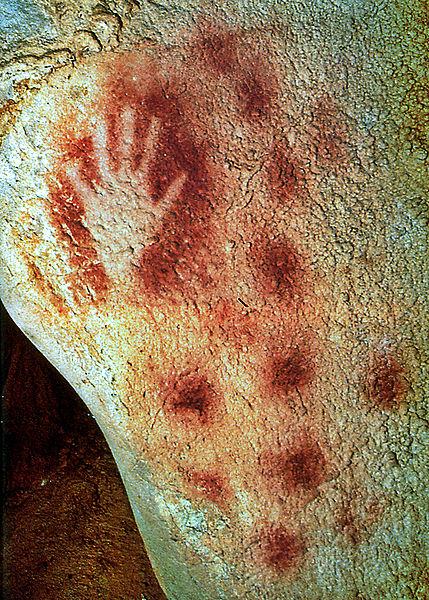
Another
female hand stencil and dots. The dots were made with the flat hand
dipped in red ochre.
Hand stencils appear in many paleolithic cave paintings, as in fact
they occur in much later African, Australian, and North-American
Indian rock paintings. They are not a sign of great age or of
Neanderthal authorship.
On female hand stencils see: Penn
State U pdf
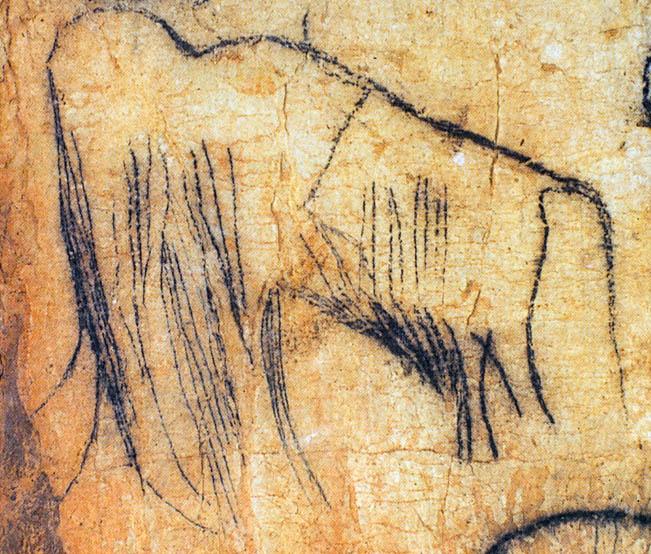
n
impressionist wooly mammoth drawn by an artist's hand which rivaled
Picasso's

A
man killed by spears and a “Placard Sign”, 75 cm high, Solutrean
20 000 BP? Photo Michel
Lorblanchet
The most enigmatic findings in several caves in the area were a dozen
of signs named: “aviforms” (in the shape of birds wings). It has
been suggested that such signs, which are found in the Charente (Le
Placard) and in the Departement Lot (Pech Merle, Cougnac),
stand for a cultural group or a group with a common ancestor, who
attended these caves separated by more than 150 km from each other.
A depiction of a speared man is equally rare (there exist 2 other
much less explicit drawings). Possibly the associated Placard Sign
indicates war fare between two tribes or groups: “kill the
bastard!”
Ths raises the interesting question: was the man a Neanderthalian and
the aviform-group H.sapiens? There exists an earlier example of a
potential killing of a Neamderthal man by H. sapiens sapiens from
Shanidar.
For more on Pech-Merle see Wikipedia
Pech Merle
and Don's
Maps
Grotte de Cussac
Dordogne, France (the exact location of the cave is kept
secret!
22 000 BP
The prehistoric cave of Cussac was discovered by Marc Delluc in September 2000 in the Dordogne Valley. With hundreds of Paleolithic engravings dating to over 22,000 years ago, it can be considered the "Lascaux of engraving".
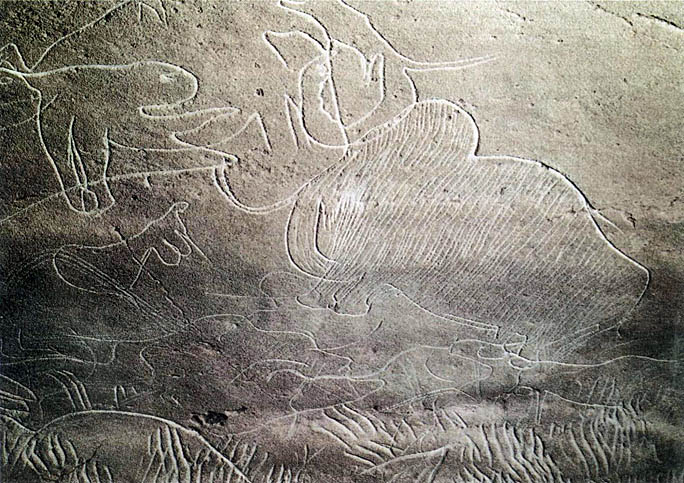
Engraving,
a wooly mammoth and a woman or two and other fantasies
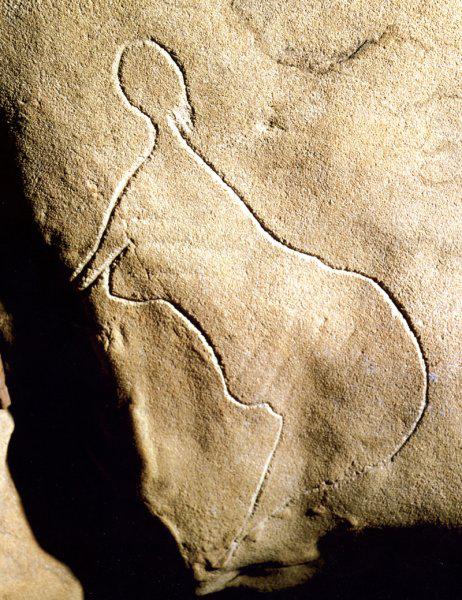
A
rare, naturalistic engraving of a pregnant(?) woman
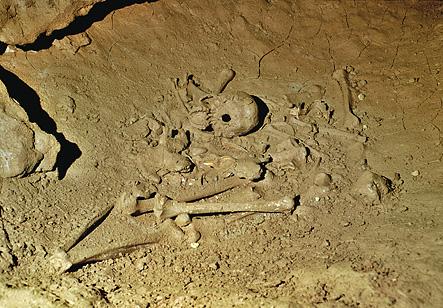
For
once people were buried in this cave: human bones in a cave bear lair
The human remains from the Grotte de Cussac are currently the most
complete skeletons and the oldest found in France in a Gravettian
context. This is the first time in Europe that the contemporaneity of
deposits, probably intentional, discovered in a cave decorated with
parietal (wall) engravings may be considered and a relationship
between rock art and funerary practices could be discussed.
Photos
and text from Don's Maps
La Pasiega
Puente
Viesgo, Cantabria, Spain
20 000-15 000 PB
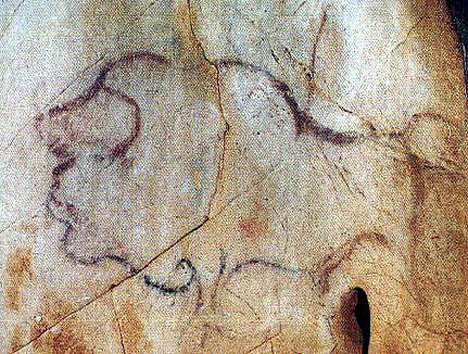
A
highly stylized multicolored bison
Cueva de La Pasiega, or Cave of La Pasiega,
situated in the Spanish municipality of Puente Viesgo, is one of
several monuments of Paleolithic art clustering around Altamira in
Cantabria, which since July 2008 have been included in the UNESCO
schedule of Human Heritage, under the citation "Cave of Altamira
and palaeolithic cave art of Northern Spain."
The recorded
remains belong mainly to the Upper Solutrean and the Lower
Magdalenian ages, although older objects are also found. Throughout
the cave are many 'walls' with paintings and with engraved or incised
images. There are representations of equines (horses), cervids (deer,
male and female) and bovines (cattle). There are also many abstract
symbols (ideomorphs).
For a detailed discussion see
Wikipedia
Other
images: Pasiega
and the Werner
Collection
Lascaux
Perigord, France
17 300 BP
See my chapter on Lascaux
Grotte de Mas d'Azil
Le Mas-d'Azil, Ariège, France
16 000-15 000 BP
The cave of Mas-d'Azil is a large, 500 metre long tunnel dug by the Arize River through a wall of the Massif Plantaurelin, part of the Ariege Pyrenees. Secondary caves leading off the main tunnel were occupied at various prehistoric and historic times during a period of 20 000 years, and the objects found there gave the name of the cave to a prehistoric culture, the Azilian. It was excavated by Edouard Piette in the 19th century, who interpreted the halter-like marks on animal heads as being evidence of the domestication of reindeer and horses.

Head of a neighing horse, reindeer antler, 15 000 BP (photo enlarged)
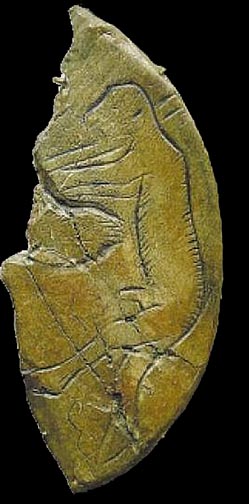
A
disk carved from a scapula (bovine?), fragmented, 78 mm x 37 mm.
These are a stunning pieces of work. The disk had originally an engraving on both sides. On one side of the disk is decorated with a human male with an erect penis confronting a bear, with a heavy stick over his shoulder, on the other, a man being struck down by a bear. He appears to be shown lying face down, there is no other palaeolithic representation of a man in such a position. If the disc is tipped upside down on this face, a horse can be seen.
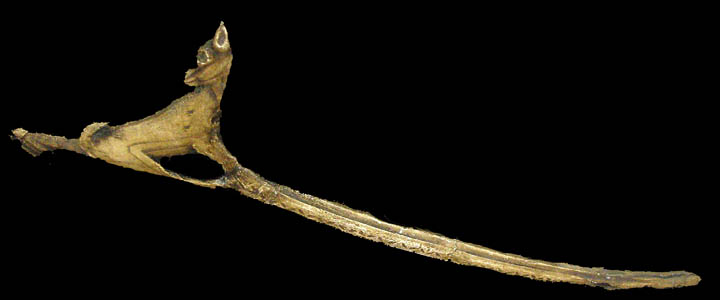
A
spear thrower carved in the form of a chamois fawn, 29.5 cm antler,
16 000 BP, Magdalenian
Spear throwers were invented by H. sapiens as they entered Europe in the 30th millenia BC. They encreased the power of a man's arm several times, and allowed the use of much lighter spears
Gönnersdorf-Lalinde
Andernach-Neuwied,
right bank of Rhine, Germany
16 000-14 000 BP
The site of Gönnersdorf is situated on the right bank of the Rhine, at the north-western exit of the Neuwied Basin, about 15 km northwest of the city of Koblenz and immediately east of the Andernacher Pforte (Andernach Gate)
The site was found on a spur of a triangular piece of land, which is
3 km long and 1 km wide. Directly west of the settlement, was a small
stream running through a narrow, steep valley, draining into the
Rhine. The valley both protected the people from the worst of the
weather, and supplied them with the slate that was used for pavement
in the settlement area. Towards the northwest, the site was protected
by the slope of the high terrace, and was easily accessible only from
the east.
The settlement is strategically placed, oriented
towards south and is exposed to the full trajectory of the sun and
has an excellent view over the Neuwied Basin. The settlement
structures were buried by pumice after the last large eruption of the
Laacher See Volcano , located 11 km west of Gönnersdorf, in the
middle of the Allerød interglacial, about 10 900 BC.
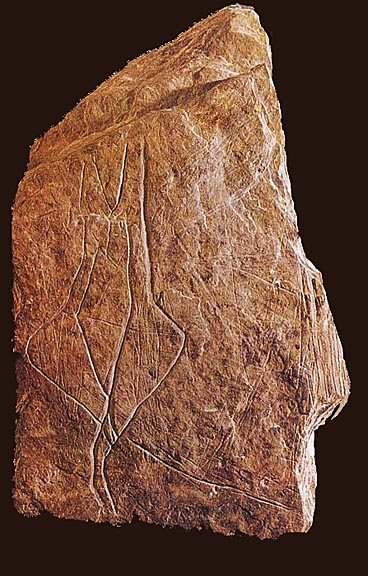
“The
Dance,” engraving, 20 000 BP
It looks like the two women are
dancing the Tango!?

Four
sylized women, bone, 15 000 BP
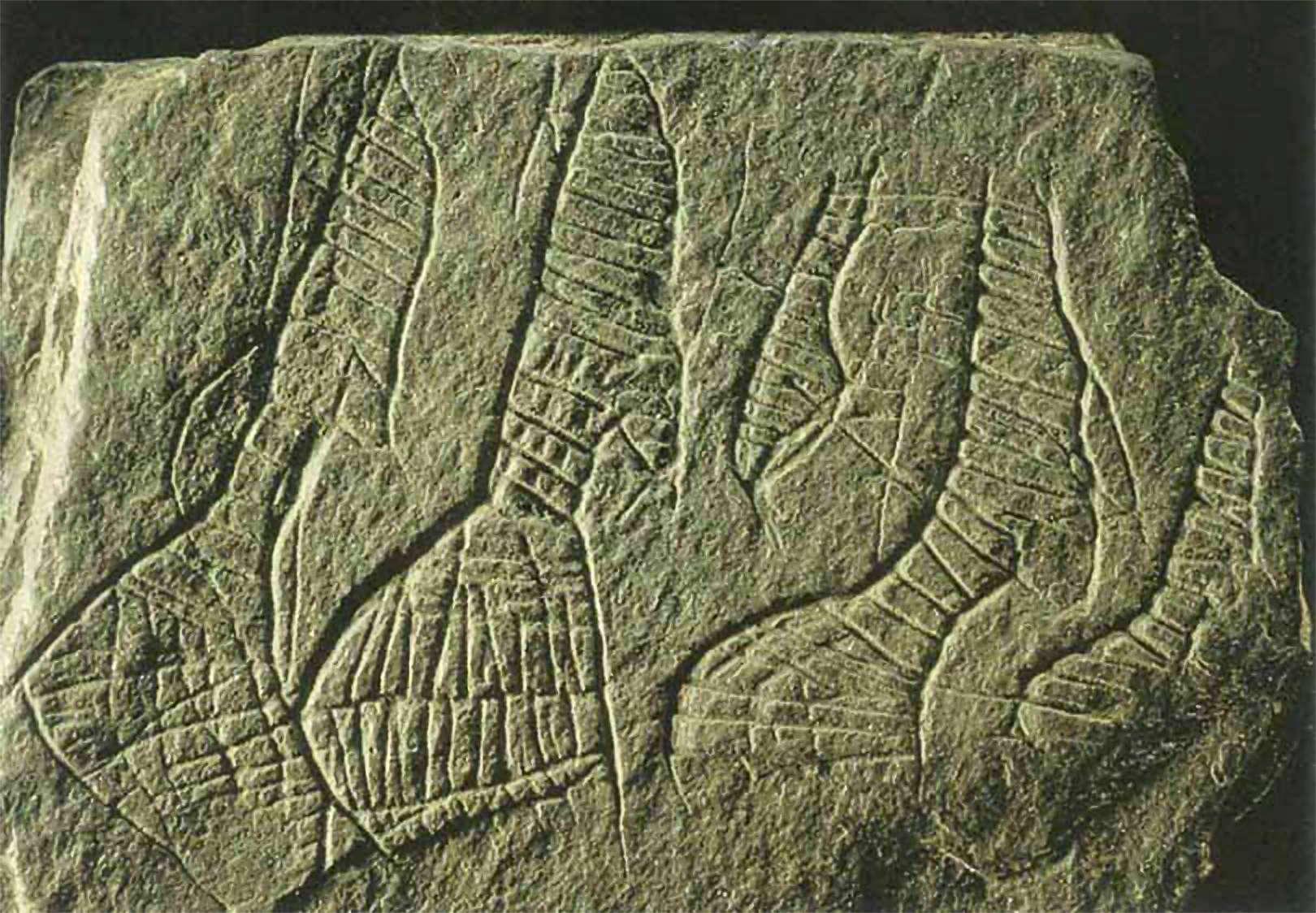
Three
engraved women and two children, one woman with a baby facing
backwards from a cradle on her back.
Photo Landesmuseum
The open-air site of Gönnersdorf was discovered and partly destroyed
in 1968, during the construction of a cellar for a private house in
Feldkirchen-Gönnersdorf. After digging through the pumice, bones and
slabs of stones appeared and it became clear that what one was
dealing with was a location of the Late Glacial. A few days after the
discovery, Dr. Gerhard Bosinski from the University of Cologne was
put in charge of further investigations of the site. Two excavation
campaigns were conducted the same year, excavating the part called
Concentration I (CI).
During these two campaigns what we today
know from Gönnersdorf as the typical inventory was unearthed: the
pulverised red hematite, a fireplace, features from habitation
constructions, lithics, statuettes of ivory and antler, engraved
slate plaquettes, jet beads, perforated animal teeth and a well
preserved faunal record. Based on these finds it was early evident
that Gönnersdorf was a site of inter-regional importance.
Text
Don'sMaps
Les Combarelles
Les
Eyzies-de-Tayac, Dordogne, France
14 000 BP
A long, narrow cave near Les Eyzies in Dordogne, France, famous for its prehistoric engravings.
The cave's hundreds of sometimes superimposed engravings, dating to the mid-Magdalenian Period of Paleolithic art (about 14,000 years ago), were discovered in 1901. Most of the images depict horses, bison, deer, and mammoths, but the cave also contains noteworthy images of bears, rhinoceroses
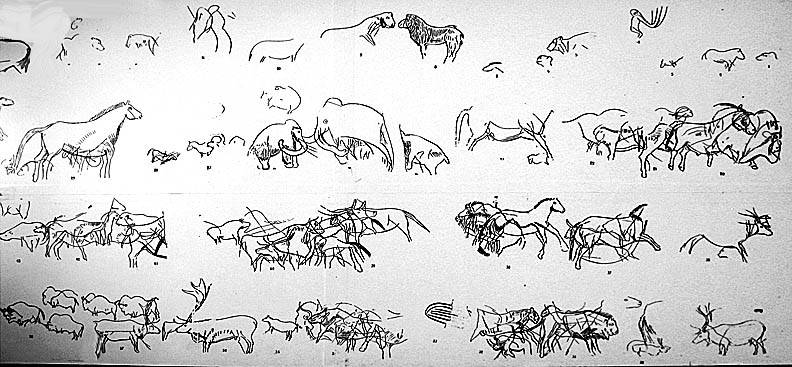
Part
of the 12-m long redrawing of the long march of engraved animlas on
the wall of the cave.
“In September 1902 we recognised on the walls of Les Combarelles
109 perfectly distinct figures, representing a series of engraved
animals of various species, the entire animal or just the head alone.
We have represented all these animals on a strip which measures
12 metres long and 12 centimetres high, at about one tenth of the
natural size, and we place these here for the eyes of the Academy, as
well as 27 tracings of the principal figures.
These images
engraved on the walls begin at 125 meters from the entrance.
The
cave has the shape of a long winding corridor, with a height of 50
centimetres to two metres, and a width of 1 to 2 metres. They extend
over a length of 100 meters on each side of the cave, almost to the
end, which is 235 meters from the entrance.
Engraved sometimes
deeply (4-5 mm) In the Cretaceous limestone, sometimes slightly more,
sometimes enhanced with a stroke of black paint, these figures
measure 25 centimetres to over a metre in length.
Many are coated
with a calcite coating measuring a few millimetres thick which acts
as a glaze on the drawings, while in other points the calcite hides
them completely. The animals represented as entire are horses,
bovidae, bisons, ibex, reindeer, and mammoths, not to mention
unidentified animals, various heads, and many drawings unable to be
interpreted.
The drawings are always executed in profile, and
show the animal at rest or walking, sometimes running. Their
technique is identical to that of engraved bone or ivory found in
deposits from the Magdalenian period. They have a character of
precision and skill, showing the constant concern to reproduce nature
as it is, with no idea of stylisation. As for the engraved bones, it
appears evident that the figures have been executed by the artists of
the time as exact replicas of what they saw.” Quote: Capitan and
Breuil (1902)
From Don's
Maps who also reproduces the remainder of the scroll.
Grotte de Niaux
Niaux,
Ariège, France
13 850-12 890 BP
Niaux Cave, or la Grotte de Niaux is one of the most popular prehistoric caves in France. It lies in the northern foothills of the Pyrenees, and is located in Ariège, in the valley of Vicdessos, across the valley from the smaller Grotte de la Vache, in an area rich with prehistoric sites. The huge cave entrance, 55 metres high and 50 metres wide, is at 678 metres above sea level. There are more than two kilometres of galleries, with a hundred or more superb paintings from Magdalenian times, most of which are in the 'Salon Noir', 800 metres from the entrance. Many of the paintings are done in the classic style of the Magdalenian, outlined in red or black pigment, mostly haematite or manganese dioxide respectively.
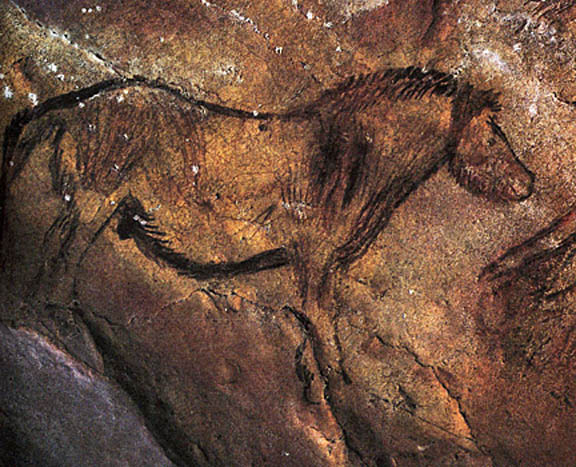
Horse
with coat markings shown by hatched shading. Salon Noir, Niaux,
Ariège. Length 30 cm
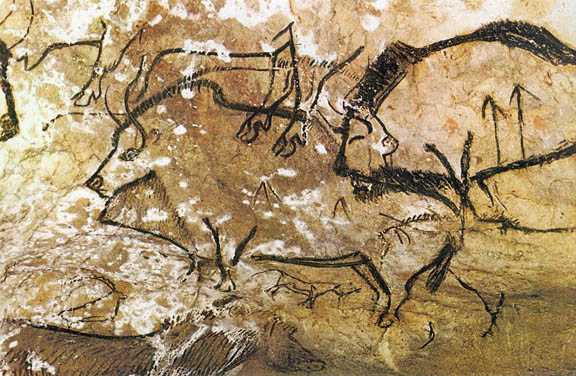
Two
bisons one painted on top the other
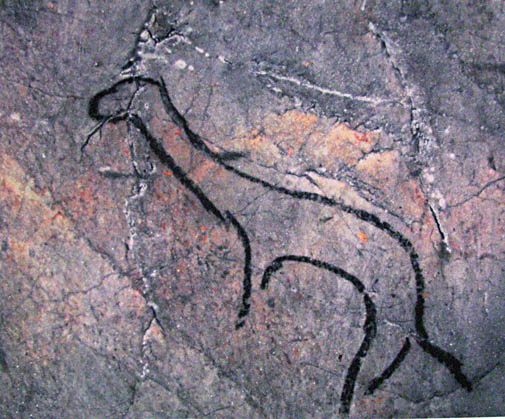
A
very rare outline drawing of a weasel
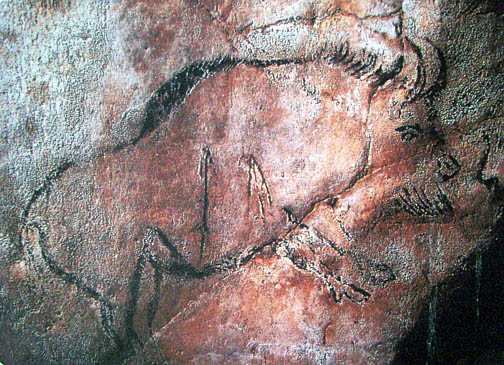
This
bison from the Salon Noir has been given a radiocarbon date of 12 890
±160 BP
Text and photos from Don's Maps
Les Trois Frères + Le Tuc
D'Audoubert Caves
near Montesquieu-Avantès, Ariège,
France
14 000 BP
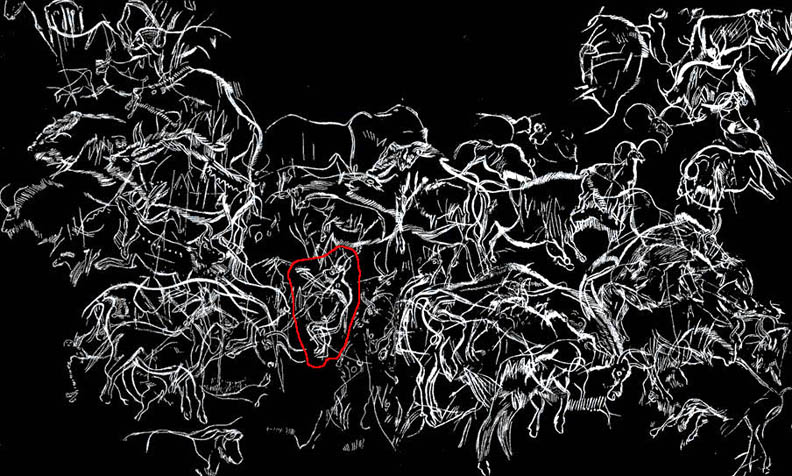
Tracing
of the large panel of engravings in Les Trois Freres. Width of panel
285 cm,.
Notice the Shaman sitting among the animals!
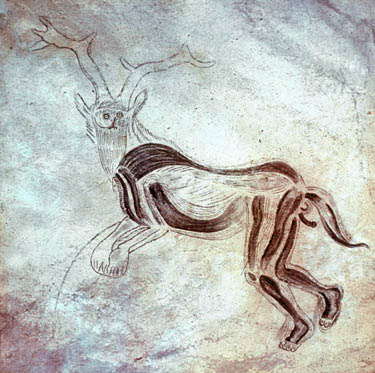
“The
Sorcerer”, a drawing of another shaman in the “Sanctuary” of
Trois-Freres. Tracing by Henri Breuil (1920)
The shaman is wearing
a deer mask with mighty antlers and a tail over his scrotum.
Certain
modern scholars question the validity of Breuil's sketch, claiming
that modern photographs do no longer show the famous antlers.

The
complex floor plan of the interconnected two caves
The cave was discovered in 1914, and most of the pictures of animals,
together with a couple of therianthropes (half-human, half-animal
figures), are located on the walls of a deep interior chamber known
as the Sanctuary. This area is filled with some 280 often-overlapping
engraved figures of bison, horses, stags, reindeer, ibex, and
mammoths. The great majority probably date to the mid-Magdalenian
Period (about 14,000 years ago).
Don's
Maps
Rouffignac
Rouffignac,
Charente-Maritime, France
13 000 BP
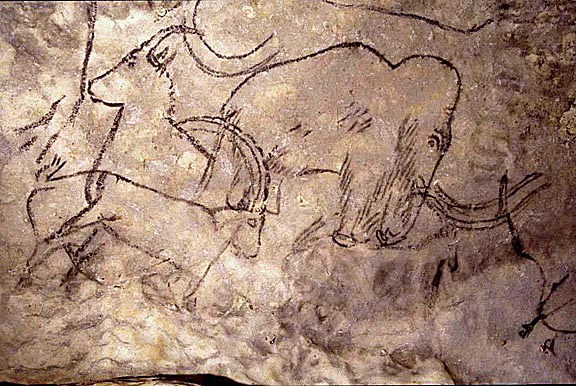
“Le
Grandpere” and ibexes
The cave of Rouffignac, La Grotte de Rouffignac, has been known for centuries and was described in 1575 by Francois de Belleforest. It is located in the heart of the Perigord, between Bergerac and Sarlat in the Dordogne region. The site has more than 250 etchings, line drawings and cave paintings dating from the Upper Paleolithic (Magdalenian, more than 13 000 years BP). With a length of over eight kilometres, this cave is one of the largest painted caves in Europe.
Visitors use an electric railway to gain access to the cave. Research
has identified numerous traces of claws and lairs left by the cave
bear before human intervention. These galleries were decorated with
158 mammoths associated with woolly rhinoceroses, bison, horses and
ibex. The figures are deeply engraved or painted black. Tectiform
signs and four human figures are also present
From Don's
Maps